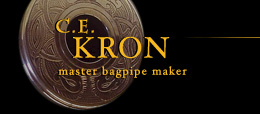|
Half mounted bagpipe, in cocus wood with
cocus button mounts and sterling silver ferrules, including
ferrules on the mounts. Mammoth ivory ring caps and bushes.
In the 19th century cocus was the
preferred wood for woodwind musical instruments, including the
bagpipe. It was also widely used in the early part of the last
century, but as it became scarcer and pricier it was gradually
and steadily replaced by African blackwood. The tree grows in
Cuba and Jamaica; with the depredations of communism it has
become almost extinct. There are reasons it was preferred: from
the customer's point of view it has none of the drawbacks of
African blackwood and all of the advantages.
The bore design is the Kron Standard, and the profiles and shapes are
as described here. The shapes of the
button mounts are very typical of David Glen as can be seen in the pictures.
The ring caps are made with a little step in the bead, similar
to those made by Donald
McDonald. The combing and
beading is of course first rate. Overall the look is very much 19th century Edinburgh.
All the cocus parts are fitted
according to proper tightness. The mounts are fitted so the
threads touch closely only at the bottom, where the pin meets the
mount; it is here that the short silver ferrules are fitted to
prevent the mounts from cracking. From there the taper in the mount
thread moves away from the wood as it approaches the end where
the combing and beading is. This also helps to prevent cracking by
having no outward pressure on the mount where the mount is
thinnest. I have put very fine detail on the mounts, which use
of cocus allows. It is details like these, which are repeated
throughout the pipe (and every other pipe made here) that set my
products apart from those made by all other makers.
An important advantage of cocus over
African blackwood is that it takes shellac very well. I have
finished this pipe with shellac.
Everything on the pipe was made in this shop. Such control of
materials allows me complete control over the quality of the
final product.
I used ivory from two different mammoths.
The color of the ring caps is milky white. The color of the
bushes is much darker and brown. This contrast in colors mirrors
that of the heartwood and bark of the cocus. There is a lot of
bark on the tops, particularly one tenor top. It is very
difficult to turn wood with bark, and care must be taken not to
tear any of the combs.
The blowpipe is the "no-touch" brass sleeved system I
invented a few years ago, with a brass tube connecting the brass
tenon and aluminum tip at each end. They are sealed against
moisture and air leakage, so the wood is protected
from attack by external moisture.
|
